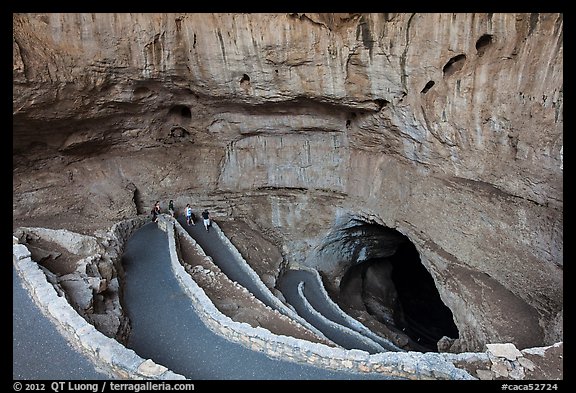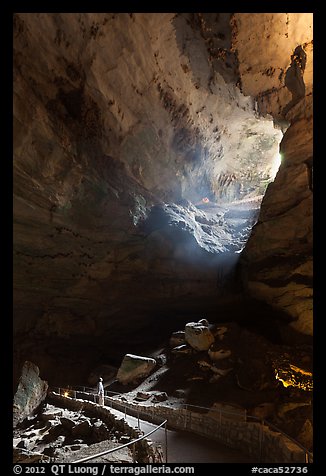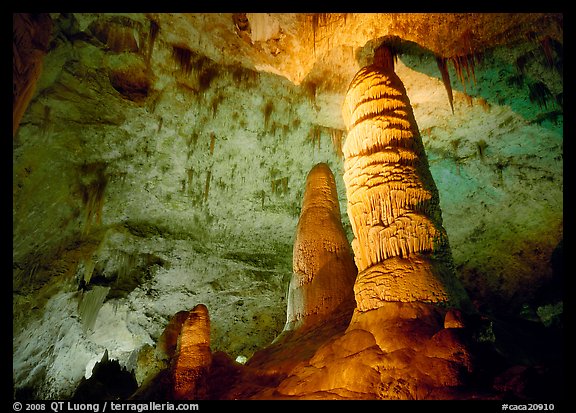Back to Carlsbad Caverns,
2 Comments
During my two previous visits to Carslbad Caverns, more than a decade ago, I took the elevator to get quickly to the most scenic section of the Cavern, the Big Room. This time, I walked down from the Natural Entrance.

I tried to make images to illustrate the experience of visiting the cave: the cavernous space, pathways, including a human figure for scale. Since nobody would stand still at the right spot for a multiple second exposure, I posed myself, using an intervalometer to extend the 10 second self-timer which was not long enough for me to get into position.

The Natural Entrance has fewer spectacular cave formations than the Big Room, but the sense of scale that it added through the long descent gave me a new appreciation for the size of the cave.

Back in the Big Room, the density of cave formations struck me. I was interested to see how different digital cameras reacted, compared to the film cameras that I used during my previous visit (high-resolution digital didn’t exist yet). Digital helped when I photographed the Painted Grotto. Like most films, Velvia is balanced for daylight. Cave lighting here use fluorescent lights. Although they look white to the eye, they are much more cold, and turn very green on film. Anticipating the problem, I did use a magenta color-correction filter on my previous visit, but it turned out not to be strong enough (difficult to estimate if you don’t own a color meter !), so the resulting slides still took a sickly green tint. I just tossed them. Digital processing was not included in my workflow at that time, but since then I’ve noticed that when all the information ends up in the green channel, with little in the red and blue channels, then even after photoshop color correction, tonality is quite poor.

This time, working in digital, I was at least able to make a proper picture. It also helped that I could blend two exposures to get details everywhere, as the speleotherms close to the lights are much brigher than the rest of the scene. On the other hand, for some other rock formations, the improvement wasn’t as marked. Here is the new digital image (single exposure) of the six-story tall column in Hall of Giants:

Here was the film image (5×7 transparency). Besides higher contrast, resulting in less highlight and shadow detail, you can notice that fluorescent light coming from the left was rendered much greener. In that particular image – and also in images of the Chandelier – this helped by creating an interesting color contrast. Because spectral response of digital and film is different, unlike for natural light images, it is not possible to duplicate easily that effect by changes in digital processing.

Do you prefer the digital image or the film image ?
More images of Carlslbad Caverns National Park
Part 3 of 5: 1 | 2 | 3 | 4 | 5


I like the film shot because of the color cast in the background. I’m sure have pros and cons to them in other situations though.
I slightly prefer the film shot because it has more contrast, even though I dislike the green cast. The digital shot is very likely a much more accurate representation of the situation, and that makes me like the film shot less. (Yes, the question was about preference, but I find it difficult to react to the photo on a purely emotional level when I know the technical details.)
A couple of things have changed over 10 years:
– The film shot was (close to) state-of-the art 10+ years ago (with known limitations such as green sensitivity), and the digital shot is state-of-the art present-day (with presumably far subtler known limitations).
– The lighting almost certainly has changed. Fluorescent bulbs age, and many likely were replaced with newer technology with a different color spectrum. Looking at the shadows, it appears that there is some other (non-fluorescent-colored) light source present in both shots.